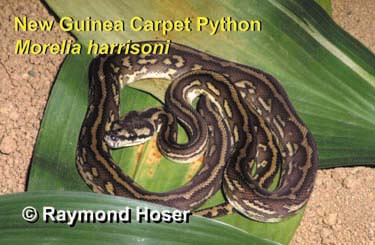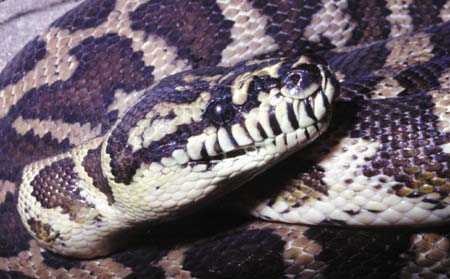MORELIA HARRISONI SP. NOV.
|
Scroll down the page to view a photo of this snake or to download a .61 MB or 2 MB high resolution image/s: |
HOLOTYPE: A female specimen, at the American Museum of Natural History (AMNH 82433) New York, from Port Moresby, PNG. Lat: 9°30' Long: 147°10' collected on or near 30 August 1959 by the Spalding-Peterson Expedition.
PARATYPES: A female specimen, at the American Museum of Natural History (AMNH 103637) New York, from Port Moresby, PNG, . Lat: 9°30' Long: 147°10' collected on or near August 1968 by Roy Mackay. A specimen, at the American Museum of Natural History (AMNH 107157) New York, from Mawatta (=Katow), Western District, PNG, . Lat: 9°10' Long: 142°55'
DIAGNOSIS: A medium to large python similar in most respects to the others in the genus Morelia. It is separated from its closest relatives Morelia cheynei, Morelia variegata, and Morelia macdowelli all of which occur in the top third of Australia. Morelia harrisoni is separated from these three species by distribution, being the only 'Carpet Python' known to occur in New Guinea. The snakes labeled by Barker and Barker (1999) as 'Irian Jaya Carpet Pythons', 'Trans Fly' Carpet Pythons' and 'Port Moresby Carpet Pythons' are all of this species.
The specimens allegedly from north of the Central Dividing Range in New Guinea are also believed to be of this species. In New Guinea the apparently disjunct distribution probably reflects either a paucity of collection records and/or intervening areas of unsuitable habitat. The preferred habitat is open savanna woodland such as that found around Merauke in Irian Jaya and near Port Moresby, PNG. In appearance, Morelia harrisoni usually looks somewhat intermediate between Morelia variegata and Morelia cheynei although Morelia harrisoni is highly variable in colouration, both between different localities, within the same locality and even within a single litter of offspring.
In line with Morelia variegata, Morelia harrisoni young are often reddish in colour. Morelia harrisoni is one of the smaller varieties of Carpet snake. Adults average slightly less than two metres in total length. It is not known by this author to exceed three metres in length.
The Morelia harrisoni sighted by this author tend to have a lower average ventral and subcaudal scale count than Morelia cheynei, Morelia variegata and Morelia macdowelli, however the sample seen is too small to conclude if this trend is general. Further diagnostic information for the species is provided by Barker and Barker (1999). They also provide photos of this species in life. However again this author notes the general variability in colour in this species and the fact that colouration does change with age.
Like all Carpet Pythons Morelia harrisoni is almost always dorsally patterned with a combination of cross-bars, blotches and spots, occasionally in a manner approaching longitudinal blotches or stripes. Morelia harrisoni can best be definitively be separated from the other species of Morelia by DNA analysis. Morelia harrisoni is being bred in captivity in the northern hemisphere. Within Australia, the few specimens kept in captivity, including a subadult specimen at Sydney's Taronga Zoo, presented no husbandry problems. However some specimens, particularly juveniles and subadults were snappy in temperament.
ETYMOLOGY: Named after David Harrison who died of cancer in 1999. Harrison was best known as a leading edge aviculturist. He was also well known as editor of the journal Avinews, through which he played a pivotal role in exposing corruption and misconduct in Australian wildlife departments, in particular NSW. Harrison played an essential role in bringing about a re-write of reptile licencing laws and procedures in NSW, however since his death, others who played no useful role in bringing about the change are claiming some of the credit he deserves.
The above was from the paper - A revision of the Australasian Pythons.
(Originally published in Ophidia Review 1(1) in "Autumn" 2000 - (Publication date: October 2000), pp. 7-27).
For the text of the full paper ![]()
 Download the full paper as an MS Word document (better for printing)
Download the full paper as an MS Word document (better for printing)![]()
|
For a relevant clipping from Australian Birdkeeper magazine 14(7), Feb/Mar 2001 |


 To download the original of this paper - with
photos exactly as it appeared in the journal Ophidia Review - as an Adobe Acrobat pdf file
To download the original of this paper - with
photos exactly as it appeared in the journal Ophidia Review - as an Adobe Acrobat pdf file